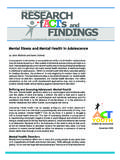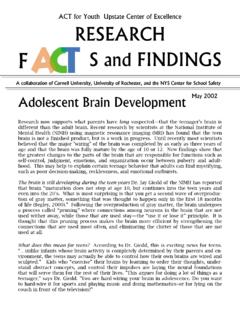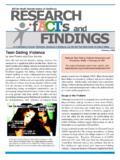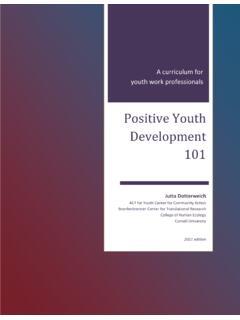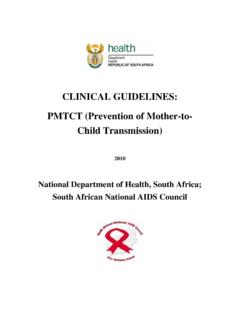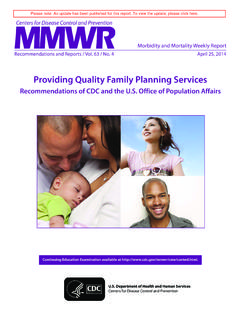Transcription of Adolescent STI/HIV Prevention Programs: What Works for …
1 ACT for Youth Center of Excellence A collaboration of Cornell University, University of Rochester, and New York State Center for School Safety Adolescent STI/HIV Prevention programs : What Works for Teens? by Jessica M. Sales and Ralph J. DiClemente In 2010, it isn't shocking news to hear that adolescents are having sex. However, in the past year, it may have shocked many to hear findings from a highly publicized national study stating that one in four Adolescent girls (ages 14-19) in the United States are infected with one of four common sexually transmitted infections (STIs), and that African American girls had a 50% prevalence of any one of the assessed STIs [1].
2 Or that approximately half of all new HIV infections occur in young people less than 25 years of age, with African American youth disproportionately affected. Unfortunately, for those engaged as clinicians, practitioners, or researchers in areas related to Adolescent sexual health, these statistics were likely not surprising. For over a decade, compared to older adults, adolescents (15- to 19-years-old) and young adults (20- to 24-years-old) have been disproportionately affected by the STI. epidemic [2]. The striking rate of STI infections among adolescents often begs two questions: 1) Why are STI rates so high among this population?
3 And 2) What can we do to prevent HIV/STI in adolescents? Here we provide a brief overview of Adolescent sexual behaviors and the current status of STI and HIV rates in adolescents, some potential explanations for why STI rates are so high in the Adolescent population, and a summary of what Works in terms of HIV/STI Prevention programs for teens. Sexual Behavior During Adolescence Many adolescents and young adults engage in sexual intercourse, often times with multiple sex partners and without using condoms. In 2007, of high school students in the reported having had sexual intercourse [3], with reporting having had sexual intercourse for the first time before age 13.
4 Although most adolescents do not have concurrent sex partners at any given point in time, the number of sex partners May 2010. Jessica M. Sales, PhD, is a research assistant professor of behavioral sciences and health education at Emory University. Ralph J. DiClemente, PhD, is Charles Howard Candler Professor of Public Health and Pediatrics, Division of Infectious Diseases, Epidemiology, and Immunology at Emory University, and associate director, Emory Center for AIDS Research. cumulates over time. Specifically, among high school seniors in 2007, approximately reported having had sex with at least four different sex partners [3].
5 Moreover, among sexually active adolescents, only reported using a condom the last time they had sexual intercourse [3]. In spite of the fact that many adolescents have used condoms at some time during an episode of sexual intercourse, comparatively few report using them every time they have sex [4]. Thus, adolescents engage in sexual behaviors that place them at risk for acquiring STIs, including HIV. STI/HIV /AIDS and Adolescents: The Extent of the Problem Globally, over 100 million STIs occur each year in people under the age of 25 years [5], and an estimated million people aged 15-24 were living with HIV by mid-2002.
6 Further, about half of all new HIV infections worldwide, or nearly 6,000 cases per day, occur in young people [6]. In the United States alone, approximately one-quarter of new STI infections, almost four million, are diagnosed among teens [7, 8]. Moreover, approximately 1,700 newly diagnosed cases of AIDS were reported in people between the ages of 13 and 24 in 2003 [9]. However, the risk of STI/. HIV infection is not uniform among adolescents. Females, men who have sex with men, injection drug users, people who have exchange sex ( , sex for money or goods), and racial minorities have markedly higher rates of STI/HIV .
7 During adolescence [10]. Explanations for High STI Rates among Adolescents Adolescents are at especially high risk of contracting STIs, including HIV, for several reasons. Below we enumerate these reasons. 1. Immature biology. Biologically, adolescents' immature reproductive and immune systems make them more vulnerable to infection by various STI. pathogens [11]. For example, cervical ectopy, a benign condition common in young girls, increases susceptibility to infection [10]. 2. Earlier sexual debut and later onset of marriage. Over the past few decades in the United States, both the onset of puberty and the initiation of sexual intercourse have occurred at decreasing ages [12], yet the age at first marriage has increased, with the median age of first marriage years for men and years for women [13].
8 Thus, adolescents usually have had sexual intercourse with multiple partners prior to marriage, thereby increasing their risk of acquiring an STI or HIV. 3. Contextual conditions. Conditions such as poverty, homelessness, political strife, and dislocation, all problems that are increasingly common among adolescents in developing countries, are associated with sexual abuse or sexual intercourse in exchange for money or support for basic needs [14]. Also, for social and cultural reasons, adolescents, especially young girls, ACT for Youth Center of Excellence 2 may be less able to refuse sex or less able to insist on adequate protection, thereby increasing their risk for STI/HIV infection [15].
9 4. Barriers to quality STI Prevention services. Often adolescents are confronted with multiple barriers to seeking Programming Resource and receiving STI testing and treatment, such as lack of insurance, lack of money to pay, lack of transportation, The CDC maintains a Compendium discomfort with facilities and services designed for adults, and of Evidence-Based HIV Prevention concerns about confidentiality [10]. Moreover, adolescents Interventions that catalogues many may be ill informed about STIs, their symptoms, the need for effective programs : treatment, and where and how they can obtain treatment.
10 Research/prs/evidence-based- HIV/STI Prevention for Adolescents: What Works ? In response to the personal and public health threat posed by STI/HIV , over the past 15 years a number of sexual risk-reduction programs for adolescents in the United States have been published in peer-review medical, public health, and social science journals. These sexual risk-reduction programs were specifically designed to reduce adolescents' STI/HIV -associated sexual behaviors and psychosocial mediators ( , attitudes, perceived normative influences, social skills) associated with STI/HIV behaviors.



